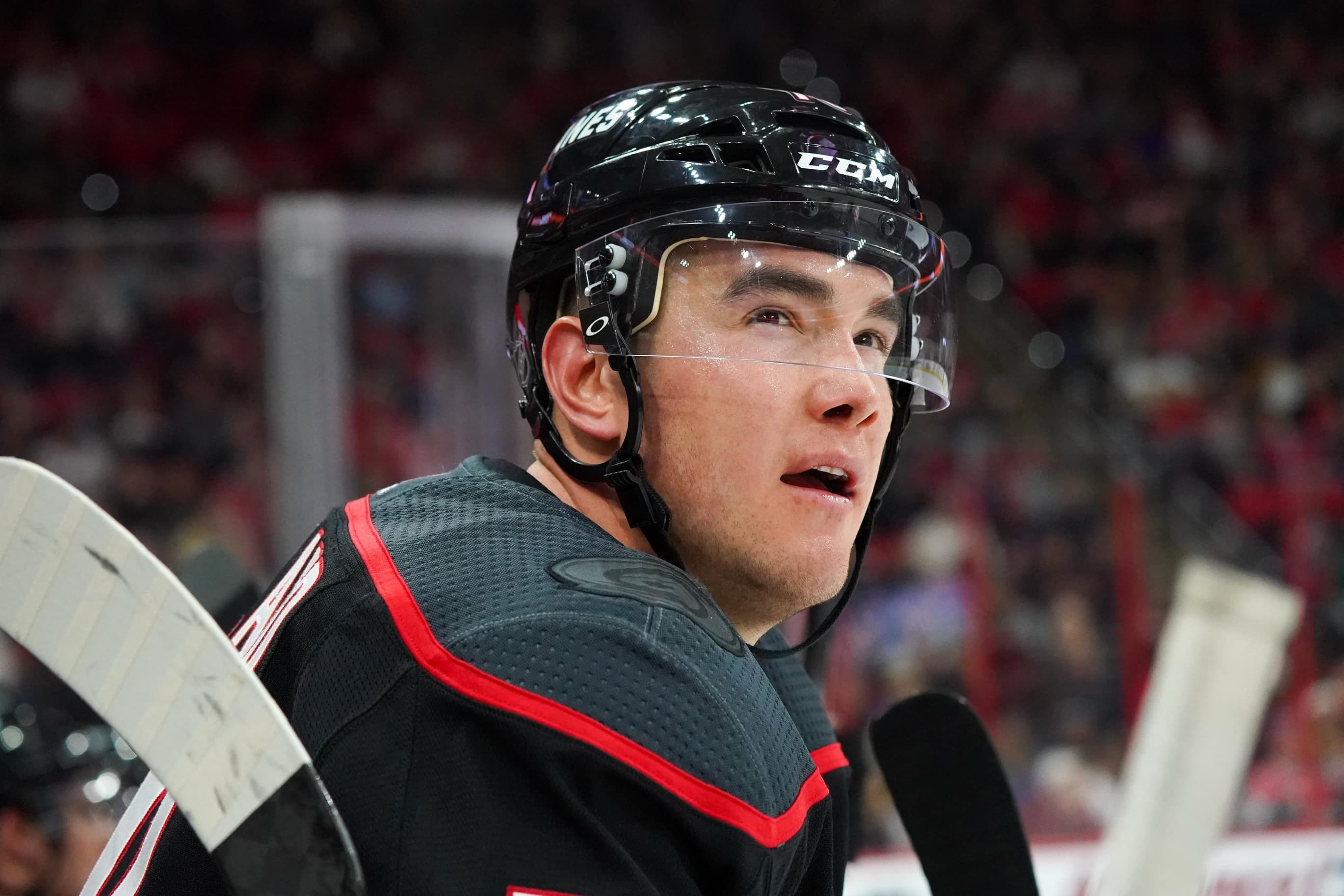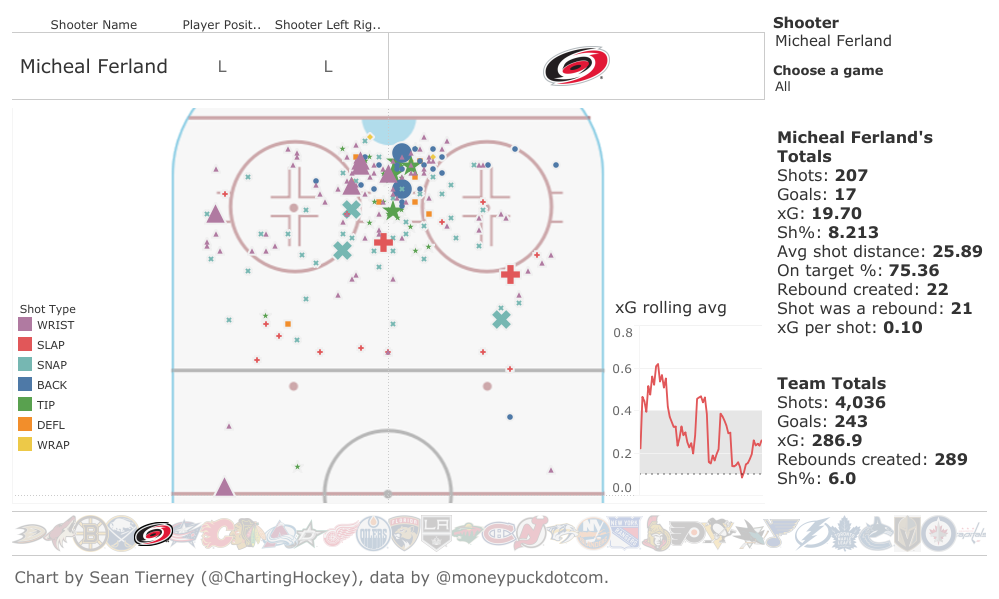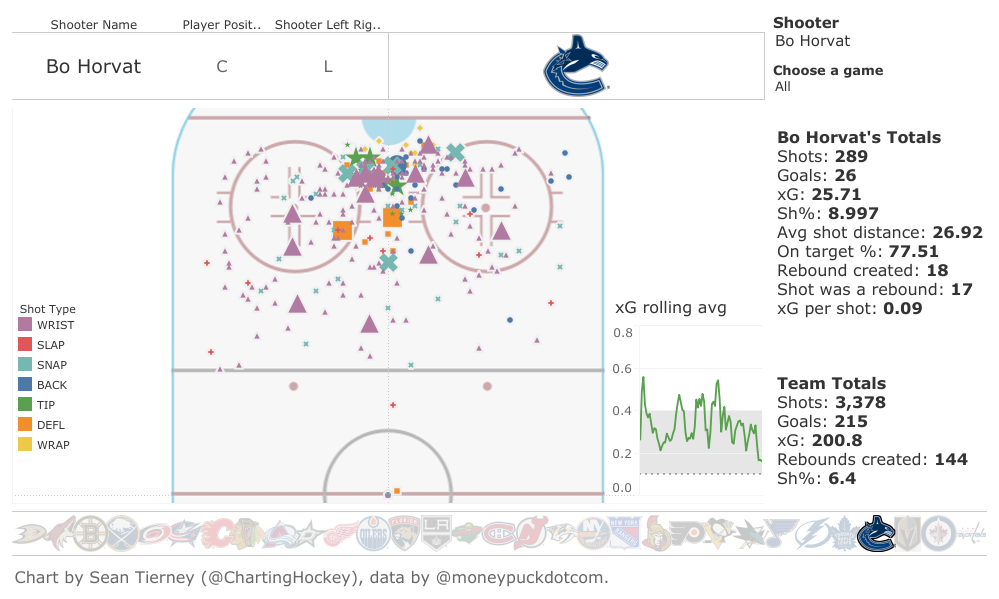Ferland’s shooting talent will prove to be useful asset for Canucks

Micheal Ferland burst into the mainstream hockey consciousness early last season after scoring seven goals in his first 12 games with his new team after an offseason trade that sent him to Carolina.The former Calgary Flame was packaged and shipped to the Hurricanes with Dougie Hamilton for Noah Hanifin and Elias Lindholm. Early on in the 2018-19 season, it seemed like a steal for Carolina, but after those initial seven goals coming off the Ferland’s stick, he was only able to muster 10 more in the remaining 59 games he played.
It seemed like he was going to cash-in during the beginning of last year, but through some slight misfortune for him, his stick just dried up and he was unable to get to the same level as he previously shown. Especially towards the end of the regular season where the 27-year-old had zero goals in the last 17 games before heading into the playoffs.
His postseason suffered the same fate, totalling zero goals and a single assist through an injury-riddled playoffs for the winger.
Still, now a member of the Vancouver Canucks, Ferland’s ability to get the puck towards the net and influence the play to get a solid number of scoring chances for his team is unquestioned. It might not show up directly on the scoresheet, but Ferland has his game and he plays it well.
There’s a reason why he has a career 10.5 shooting percentage.

viz by Sean Tierney / data by MoneyPuck
Most of his shots come extremely close to the crease — practically sitting right on top of the opposing goaltender hoping for any loose puck to pounce on. That is how Ferland was able to get most of his goals this past season with the Hurricanes and it will most likely be how he will score during his time in Vancouver.
It’s not the extremely skilled shooting that we have seen in Pettersson last year or an elite distance shooter like Steven Stamkos, Ferland crashes the net hard and that is his role.
There’s no nuance to his goals, but he demonstrated early on last season that he can put the puck into the back of the net. That above-average shooting percentage results from him getting in really tight and getting his chances that way.
He rarely attempts the mid-range shot, but would rather go in and get personal with the opposition deep into their own zone.
In this one sequence, Ferland grabs a loose puck off the stick of Andrei Svechnikov and goes through two Flyers to attempt a backhanded chance. It doesn’t result in a goal, but his offensive instincts is on full display here. Going for the high-danger attempt rather than putting the puck towards the net.
This is how he gets his shots to go in more than the league-average amount, opting for the higher-probability chance instead of shooting from distance and allowing the goaltender and defence to adjust.
What’s more impressive is that he goes for his own rebound in-tight and it almost becomes a goal on that second opportunity that Ferland created.
On his own rebound off his backhand, he switches to his forehand quickly and is able to bat the puck towards a fairly open net. Pulling Neuvirth out of his net with his initial shot and then seeing the rebound clearly and making it another scoring opportunity.
Highlighting this one play might be considered cherry-picking, but it does demonstrate that he does have this in his game. It wasn’t a goal that was completely set up by a linemate and Ferland was just reaping the rewards of being on the ice at the same time as a top-tier forward, but it showed his individual ability.
It wasn’t uncommon for Ferland to make individual plays either. He would sometimes rush the zone in complete control of the puck and attempt to create an offensive opportunity.
A prime example would be in one game last season against the New York Rangers. It was some atrocious zone defending by the Rangers, but Ferland took his chance and went for the shot.
Sometimes the more predictive play isn’t always the best option, if he was to lay the puck off to the teammate to his left, it might have dulled the offensive threat down, but instead Ferland decides to take his opportunity and knows that he might as well get the shot off.
It doesn’t show his shooting talent directly, but his ability to get to the front of the net and get those prime scoring opportunities.
Just like in this scoring chance during a game last season against the Washington Capitals, Ferland is able to pounce on a loose puck after sustained offensive pressure from Carolina. Then he’s able to get past some immobile defensive players and get two shot attempts off.
Again, it didn’t result in a goal but Ferland is clearly able to create this offensive pressure and keep his opposition back on their heels in their own zone.
When he enters the zone, he essentially has blinders on and darts towards the net when it’s appropriate.
He isn’t anything near a one-trick pony in the offensive zone either — at the right moment, Ferland can use his shooting ability to his advantage.
Of course being on the ice with Sebastian Aho and Jordan Staal makes his life incredibly easier, but the 27-year-old winger was able to rip a shot on the rush as the third forward entering the zone.
Perfectly placed and perfectly timed.
This is definitely picking one good play out of his 1001 minutes he played this past season, but it demonstrates that he can score some goals and beautiful ones too.
How he acts in the offensive zone led to more chances created. He was part of a Hurricanes team that were expected goals monsters last season, leading the league in xGF% for most of the season. While there were other Carolina forwards that were dominant by this metric, Ferland still carried an on-ice 54.32 xGF% at even-strength, well above league median.
That is just when Ferland is on the ice as well. Individually, he’s at the top tier of the league when it comes to generating expected goals.
Among forwards that played at least 200 minutes at even-strength last season, Ferland ranks 12th in individual expected goals per hour. His 1.06 ixG/60 is just slightly lower than John Tavares (1.08), and above other top-line wingers like Max Pacioretty (0.96) and Vladimir Tarasenko (0.91).
The way he is able to get his scoring chances so close to the net helps this number increase. Obviously the closer you are to the net, the more likely the attempt will become a goal.
Ferland benefitted greatly with the talent around him, playing with Teuvo Teravainen and Aho the most out of any other Carolina forwards. But his future with the Canucks can look fairly similar due to the amount of young talent this team already has on their roster.
He will definitely be lodged into a top-six role in Vancouver — they simply do not have the depth at his position to force any other decision by Travis Green. His future success with his new team all depends who is his centreman though.
In Aho, Ferland had a linemate that was able to create scoring chances out of nothing and get some clear chances against his opposition, with the winger picking up the scraps.
But in Vancouver, there are two options — either Bo Horvat or Elias Pettersson. Horvat had Loui Eriksson to his left for the majority of last season, while Pettersson had Josh Leivo. Neither are deserving of a top-six role on a team that hopes to be competitive sooner rather than later.
It might not be as easy as seeing what kind of styles either centre play and matching Ferland up with the best hypothetical fit, but if Ferland is the one driving towards the net there are some other options to consider.

viz by Sean Tierney / data by MoneyPuck
Horvat played especially well last season, generating a boatload of chances close to the net and getting heaps of pucks towards the opposing goaltender.
While viewing both Ferland and Horvat’s shot maps from last season, they play a similar game — while Horvat had much more ice-time and therefore a bigger total of chances. But they both have a similar gameplan and while that can work in some cases, there might be a better option that’s heading into his sophomore year in the NHL.

viz by Sean Tierney / data by MoneyPuck
An all-world talent like Pettersson deserves a winger that can do all the dirty work for him. While Ferland can certainly do the grinding-out in the corner, he’s clearly shown that he’s a talented offensive player as well.
Pettersson can shoot from practically any angle but he has historically preferred to shoot from distance and not crash towards the net. Having a winger like Ferland that drills that way with his intensity could be beneficial.
If his production continues throughout the next season, Ferland will score more goals than his mediocre 17 he did last season while also justifying his low-risk contract.
He had the talent to benefit from top players around him and he can do the exact same thing in Vancouver. He had an incredible start to his season last year but dropped off massively in the second half and throughout the postseason. If Ferland is able to continue a modicum of his early-season chance creation, he should be able to succeed next to Pettersson.
It doesn’t show up in the raw numbers, but Ferland has the mentality of a goalscorer that can compliment his team and linemates. Even though his career high is just 21 goals, given the right environment, he might be able to breakout and score many more than that.
This is all hypothetical — putting hockey puzzle pieces together and hoping that they work the same way as they have in the past can be a pointless task. But if everything just breaks the right way and some chemistry is created within the Canucks lineup, Ferland’s abilities will be noticed.
With the new additions this roster has, improvements in most areas, at least the Canucks will try to be competitive.
Rising the talent floor, deepening the pool of players that will be called upon to win some games — Ferland’s acquisition will benefit them if he’s able to continue the rate of expected success.
-data via Corsica-
Recent articles from Thomas Williams





